Almost everyone who has ever seen a gravel garden has been surprised by how beautiful they are. Contrary to what their name might suggest, gravel gardens are some of the lushest and most verdant landscapes you can create!
A gravel garden is one in which the surface is made of crushed stone. Gravel may be used as a patio surface, on a driveway, to make pathways, or to mulch plants in beds. Gravel is a beautiful material to look at. It has a smooth, three-dimensional surface that is yet uniform. It becomes an immediate backdrop for plants and fences to focus attention away from it. Everything else stands out against gravel [1] .
In this blog post, we will explore the reasons why gravel gardens are so popular and discuss some of the benefits they offer. We’ll also provide tips on how to create your own gravel garden at home!
What Is A Gravel Garden?
Gravel gardens, also known as cobble patios, are a relatively new invention that began in England in the 19th century and has sustainability and biodiversity as their ideals. If you consider garden design to be an art form, this one offers a virtually blank canvas[2] .
It creates an organized beauty with a rock as a simple and clear backdrop for the form, texture, and color of plants, as well as other garden components.
Gravel may be used to turn problem areas resulting from shallow ditches, bare spots, and high traffic regions into usable sections of the garden. These easy-care gardens require little effort yet provide a palette for a variety of flowers, shrubs, and grasses once they’ve been established. The beauty of today’s gravel garden is that it can be created almost everywhere, as long as a few fundamental building ideas are followed.
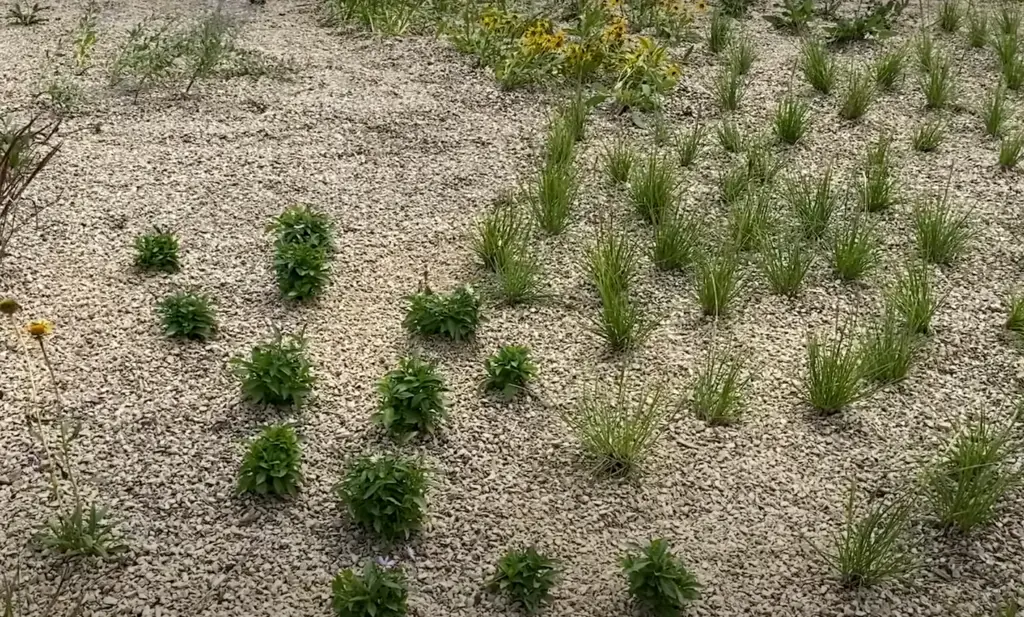
Gravel gardens are formed from the bottom up using natural and manufactured materials, and they’re constructed in layers. A broad, flat, sunny location is usually where a large gravel garden is located. Different sizes and grades of rock, on the other hand, can improve the look and usefulness of hard-to-mow or difficult-to-care-for spaces.
If you are looking for a low-maintenance option for your next gardening project, a gravel garden may be the perfect choice for you. With its easy care and versatile design, a gravel garden is sure to add beauty and appeal to any space.
What Are The Benefits Of Replacing A Lawn With A Gravel Garden
Very Low Maintenance
Gravel gardens are often chosen by people who do not have the time or inclination to maintain a traditional lawn and garden. The only maintenance required is an occasional weeding and raking of leaves in the fall.
You can also choose to add drought-tolerant plants to your gravel garden, which will further reduce the amount of time you need to spend caring for it.
Looks Beautiful
Many different types of gravel you can use in your garden, so you can find one that fits your budget and needs.
Some types of gravel even come in a variety of colors, so you can really customize the look of your garden.
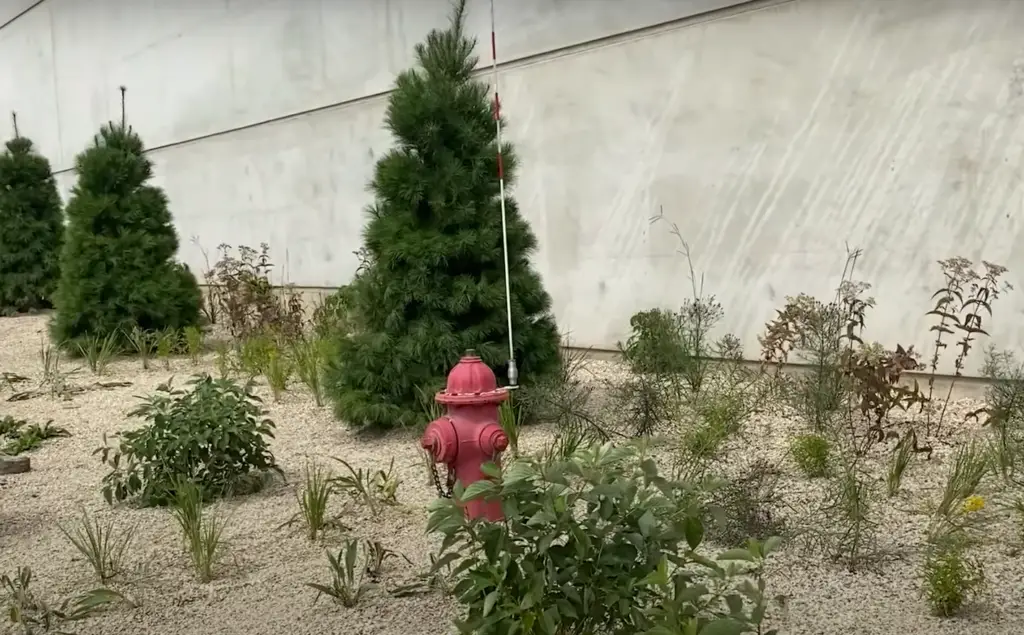
A gravel garden’s subtle backdrop adds to the beauty of your vibrant plants and flowers, allowing them to truly stand out and make a statement. Gravel may also be used in a wide variety of styles, from the modern to the Mediterranean, and it’s extremely flexible.
Disguises Unattractive Parts Of The Garden
Gravel garden paths are also a popular application of riverbed gardens since they can be used to cover off parts of the garden that would otherwise be unsuitable for growing plants owing to soil type or location.
Covering these sections with a gravel garden allows you to maintain greater design consistency and might contribute to the overall appearance and feel of your home [3] .
Affordable Landscaping Option
Gravel gardens are a very affordable landscaping option. You can find gravel at most home improvement stores for a very reasonable price. In addition, gravel requires very little maintenance, so you will not have to spend much money on upkeep.
If you are looking for a low-cost landscaping option that is still beautiful and stylish, a gravel garden is definitely worth considering.
Gravel gardens are environmentally friendly, and the materials are reasonably inexpensive and simple to install, making them a cost-effective alternative for anyone on a budget.
Climate Resistant
Gravel gardens are more climate-resistant than other types of gardens. They can tolerate extreme heat and cold better than most plants. This makes them ideal for gardeners who live in areas with unpredictable weather patterns.
Can absorb water
If you live in an area with a lot of rain, gravel gardens are a great way to prevent your yard from becoming a muddy mess. The gravel will absorb the water and help with drainage in your yard.
If you live in an area with high humidity, gravel gardens can help to keep your plants from getting too much moisture. The gravel will help to keep the roots of your plants dry and healthy [4] .
How Do I Design A Gravel Garden?
One of the best things about gravel gardens is that they are very low maintenance. They are perfect for those who do not have a lot of time to spend in their garden or for those who do not want to deal with high-maintenance plants.

Here are a few tips:
- Pick an area of your yard that gets full sun. Gravel gardens need at least six hours of sunlight a day;
- Remove all the grass and weeds from the area. You can use a herbicide to make this process easier;
- Turn the soil over with a shovel or a tiller. This will help to loosen up the soil and make it easier for plants to roots;
- Add a layer of gravel to the area. You can use any type of gravel that you like. Just make sure that it is at least two inches deep;
- Plant your plants in the gravel garden. Choose plants that are native to your area or that are known to be drought-tolerant;
- Water your garden regularly, especially during the first year after planting. Once your plants are established, they will not need as much water;
Gravel gardens are a great way to add interest to your yard without having to do a lot of work. With just a few simple tips, you can create a beautiful and low-maintenance garden that will last for years to come.
What Is The Best Kind Of Gravel To Use For A Garden?
Loose gravel is ideal for country gardens, but it may also be used in contemporary settings. It’s simple to DIY-lay and has the ability to hold water, making it an affordable alternative. It’s also great for walkways [5] .
Another type of gravel that is becoming increasingly popular for gardens is crushed stone. Crushed stone is similar to loose gravel, but it has been crushed into smaller pieces. This makes it easier to walk on and also gives it a more polished look. It’s available in a variety of colors, so you can find the perfect match for your garden.
River rocks are smooth and round, making them ideal for use as mulch or ground cover. They come in a variety of sizes, so you can create the perfect look for your garden.
No matter what type of gravel you choose, be sure to add a layer of weed fabric before you add the gravel. This will help prevent weeds from growing in your garden.
How Much Does It Cost To Install A Gravel Garden
Pros:
- For one, gravel is much cheaper than other types of mulch, making it a great option for budget-conscious gardeners;
- In addition, gravel is very easy to maintain and does not require regular watering or fertilizing like other types of gardens;
- Finally, gravel gardens are very versatile and can be used in a variety of different ways to create unique looks;
Cons:
- One downside of gravel gardens is that they can be difficult to install;
- In addition, gravel can be harmful to pets if ingested, so it’s important to keep that in mind if you have furry friends;
- Finally, gravel gardens can sometimes look a bit stark and lifeless if not done right;
Overall, however, the pros outweigh the cons when it comes to gravel gardens – they’re cheaper, easier to maintain, and more versatile than other types of gardens. So if you’re looking for a low-maintenance option that won’t break the bank, a gravel garden might be right for you!
How Do Plants Grow In Gravel Gardens?
Gravel aids in the development of plants that require strong drainage, such as native or drought-tolerant plants. To plant your flowers in a gravel garden, keep the root balls moist until they have a chance to grow below the gravel layer. You can also use a soaker hose to water your plants until they have established themselves [6] .

One last benefit of planting in a gravel garden is that it can help to deter pests. Slugs and other pests are less likely to inhabit a dry, gravelly environment. So if you have had problems with pests in your garden in the past, planting in gravel may be a solution for you.
Good Plants For A Gravel Garden
Gravel gardens are also excellent for growing succulents, cacti, and other drought-tolerant plants. The small stones help to aerate the soil and improve drainage. This type of garden is perfect for hot, dry climates or if you want a low-maintenance garden.
Gravel gardens are also great for plants that require a lot of air to the roots, such as succulents. The gravel allows oxygen to reach the roots of your plants and helps to keep the soil from getting too compacted. This is one reason why you often see succulents planted in gravel gardens.
Tips for Creating A Gravel Garden
There are a few things to keep in mind when creating a gravel garden:
- Make sure the area you want to cover is well-drained. If it isn’t, you’ll need to take steps to improve the drainage before adding any gravel;
- It’s important to choose plants that will do well in your climate and that don’t require too much water. Gravel gardens are often created in areas that experience drought conditions, so choosing plants that can survive on limited water will help ensure your garden’s success;
- Be sure to give your plants enough space. You don’t want them overcrowded, as this can lead to problems with pests and diseases. Giving each plant room to grow will help keep them healthy and allow them to reach their full potential;
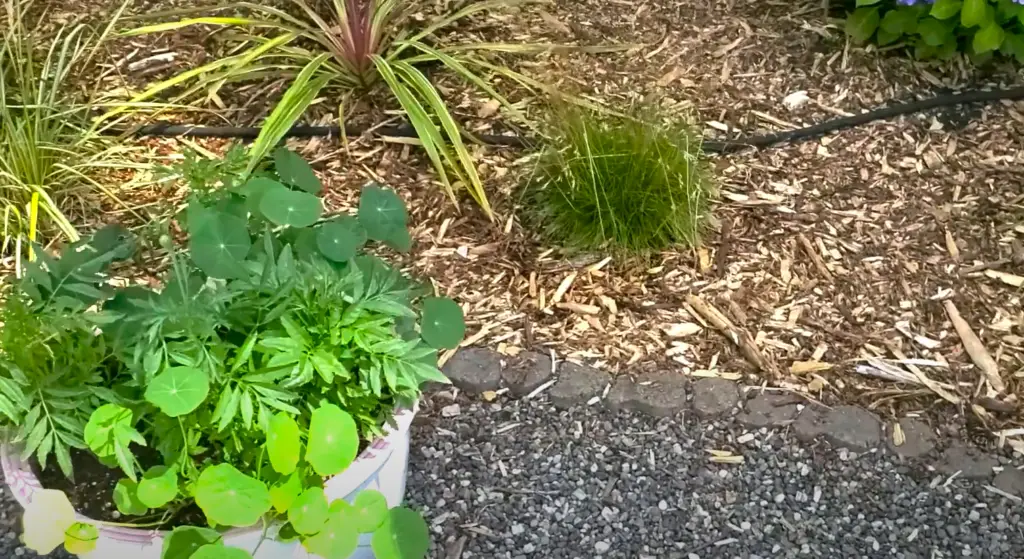
Gravel gardens are a great way to save time and money while still having a beautiful garden. If you’re thinking about replacing your lawn with gravel, keep these benefits in mind. With just a little bit of planning, you can have the gorgeous and low-maintenance garden of your dreams.
FAQ
What are the benefits of gravel?
Gravel gardens have a lot of benefits! They’re low-maintenance, drought-tolerant, and can even help with drainage problems.
Plus, gravel gardens are beautiful in their own unique way. The different colors and textures of gravel can add interest to your yard, and they’re a great way to show off succulents and other drought-tolerant plants.
How do I build garden gravel?
If you’re thinking about adding a gravel garden to your home, here are a few things to keep in mind [7] :
- Location. Gravel gardens are best suited for areas that get full sun. If you live in an area with hot summers, make sure the garden is in a spot that gets some afternoon shade;
- Soil. Gravel gardens are not meant for high-maintenance plants. If you want to grow something that requires a lot of water or fertilizer, it’s best to stick with a traditional garden bed;
- Plants. When choosing plants for your gravel garden, look for species that are drought-tolerant and can handle being in close proximity to other plants. Succulents, cacti, and sedums are all good choices;
Are rocks better than mulch?
Gravel gardens are often thought of as being xeriscapes, or landscapes that require little to no water. This is because they are usually filled with drought-tolerant plants. But what many people don’t realize is that gravel gardens can actually be quite lush and beautiful. They just require a different type of care than your typical garden.
Mulch is less effective at preventing weeds than rocks and is also less time-consuming to maintain. Stones may also improve the appearance of a property. However, rock cover is not ideal for gardens that receive a lot of sunshine since it retains more heat than mulch. In the end, it’s all about personal preference [8] .
Does rock landscaping attract bugs?
The advantage of using landscape gravel is that it doesn’t attract pests. Some bugs prefer to hide under the rocks, but they won’t stay if they don’t have a food supply. If you have a problem with bugs in your garden, it’s likely because of the plants you’re growing, not the gravel.
Insects are more attracted to certain colors than others. For example, yellow and blue flowers are more likely to attract bees. If you’re worried about bugs in your garden, choose rocks that contrast with the color of your flowers. This will make it easier for bees and other insects to find their way to the blooms.
Can plants grow through gravel?
The answer is yes! Plants can most definitely grow through gravel. The tiny little stones act as a perfect drainage system for roots, allowing them to breathe while also getting the water they need.
Gravel gardens are often drought-tolerant because of this superior drainage. This means you won’t have to worry about watering your garden as frequently as you would with other types of gardens[9] .
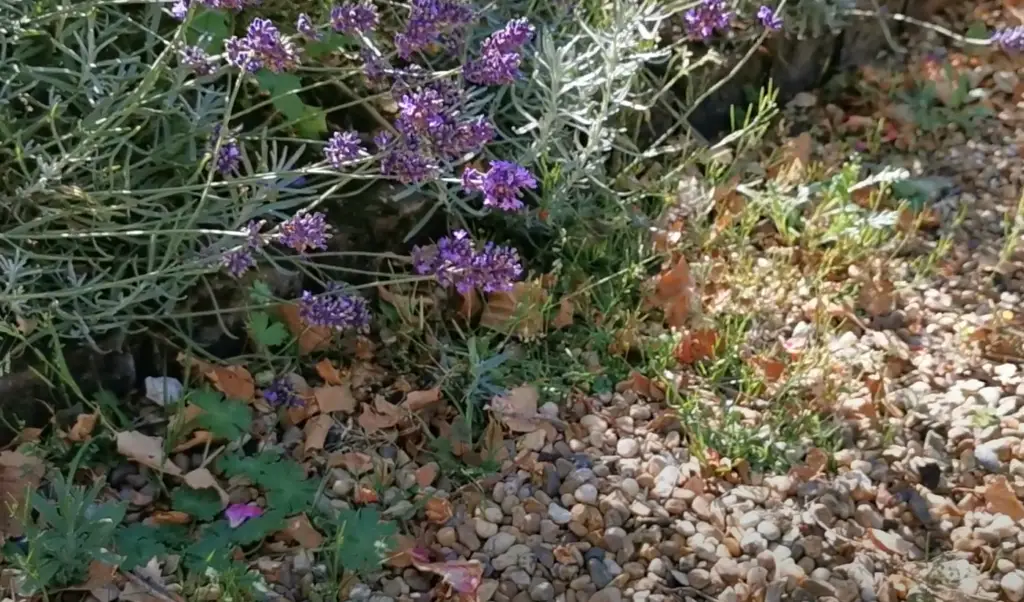
Additionally, gravel reflects light very well. This helps to brighten up shady areas in your yard that might otherwise be difficult to grow anything in. By adding some gravel to these spots, you can create a beautiful and unique garden that will stand out from the rest!
Can plants grow in gravel without soil?
Yes, plants may survive without soil, but they can’t live without the basics that soil provides. Plants require assistance, nutrients, protection from harsh weather conditions, an even amount of water throughout the year, and oxygen at the roots. It’s feasible to give these critical elements for plant growth without dirt.
Is gravel cheaper than paving?
Gravel is a very affordable option for covering large areas. A 50 lb. bag of pea gravel costs about $30 and covers around 30 square feet [10] . That’s just $0.60 per square foot!
Paving stones or bricks can cost upwards of $15 per square foot installed. So, gravel is definitely the more budget-friendly choice.
Plus, it’s easy to do it yourself! You can save even more money by installing a gravel garden yourself. It’s not difficult, and there are plenty of resources available online and in stores to help you get started.
How deep should you lay gravel?
If you can walk on it, keep it at least 50mm deep. Spread the gravel over the entire surface to make sure everything is covered. Simply rake across the whole area to assist distribute the gravel equally.
Can I plant lavender in gravel?
Yes! In fact, many plants that are typically found in a Mediterranean setting do well in gravel gardens. These include lavender, rosemary, thyme, and sedum. Gravel gardens are also a great way to show off succulents.
Can daffodils grow through gravel?
Daffodils are one of the few bulbs that will grow in gravel. They prefer well-drained soil, and gravel is the perfect way to achieve that. However, you’ll need to plant the bulbs in the fall so they have time to establish themselves before the hot summer months.
What gravel is best for gravel gardens?
Gravel gardens, also known as rockeries or xeriscapes, can be made up of any type of gravel, including pea gravel and crushed stone. The size and shape of the gravel you choose will depend on the type of garden you are creating. For example, if you want to create a drought-tolerant landscape with paths between plants, then larger stones should be used. If your goal is to have a more formal look with a neat finish, then small stones should be considered. In either case, it’s important to use permeable material that allows oxygen and water to reach the roots while preventing soil erosion. Additionally, organic matter such as compost should be incorporated into the soil to provide nutrients for plants.
Is a gravel garden a good idea?
Gravel gardens can be a great way to create an attractive landscape without requiring much maintenance. They are low in water and nutrient needs, making them ideal for areas with high temperatures or limited rainfall. Gravel gardens also help reduce soil erosion, as they prevent the topsoil from eroding away due to heavy rainfall. Additionally, gravel gardens are easy to design and don’t require frequent mowing or trimming. Finally, these types of gardens can provide habitat for beneficial insects such as ladybugs and bees, which helps pollinate plants and keep pests away naturally.
Is a gravel garden easy to maintain?
Absolutely! Gravel gardens thrive in hot, arid climates and require very little water or maintenance. Drought tolerant plants are ideal for gravel gardens, as they can survive on the minimal amount of moisture provided by rainfall and occasional watering. Low maintenance is one of the primary reasons why gravel gardens have become so popular in recent years; not only can you save time and money on your landscape upkeep, but you’ll also be able to enjoy a beautiful garden without having to worry about weeding or fertilizing.
In addition to being low-maintenance, gravel gardens also have numerous benefits over traditional grass lawns. For starters, they help reduce soil erosion as the stones hold down the soil; this means less work for you since you won’t need to worry about reseeding or re-sodding. Gravel gardens are also great for areas with poor soil, as they require very little nutrient input and can even help improve the soil structure over time. Plus, gravel is incredibly durable and won’t succumb to heavy foot traffic like grass will.
Lastly, gravel gardens offer a unique aesthetic that can be tailored to any taste or style. Whether you prefer a wild, natural look or something more structured and formal, gravel provides an ideal backdrop for creating beautiful and eye-catching landscapes. You can combine different colors of stones for interesting designs, use them alongside larger rocks for a rock garden effect, or even add in plants and trees that will provide a bit of shade.
Is it OK to put gravel next to the house?
Gravel gardens have become increasingly popular in recent years, and for good reason. The gravel provides an attractive backdrop to plants of all sizes, textures, and colors. It’s also a great way to control weeds by keeping them out of the garden area. Plus, gravel is relatively inexpensive compared to other materials used for landscaping purposes.
Gravel gardens are easy to maintain as well – simply run a rake or broom over the top from time to time and you can keep it looking fresh and clean. Gravel doesn’t require any mowing or watering either, so it’s ideal for those who don’t have a lot of time or energy to devote to gardening tasks.
Not only is gravel an attractive and low-maintenance choice for your garden, but it’s also a great way to protect your house from water damage. Gravel absorbs rainwater and helps keep it away from the foundation of your home. It can be used around trees or shrubs as well, helping prevent roots from invading the soil near them.
What do you put under gravel in the garden?
Gravel can be used to create an attractive, low-maintenance garden. To get the maximum benefit from this type of garden, it is important to understand what should go under the gravel. The most common materials used are: soil, compost, sand and mulch.
Soil provides a stable base for the gravel and helps retain moisture in the ground which is beneficial for plant growth and survival. Compost adds vital nutrients that plants need to thrive and can improve drainage when combined with soil or sand. Sand acts as a buffer between the gravel and soil and fills any gaps in the layer underneath it; this also adds some extra weight which stabilizes everything beneath it. Finally, mulch protects roots from direct sunlight while providing essential nutrients and helping to retain moisture in the soil.
Gravel gardens are ideal for anyone looking for a low-maintenance, attractive outdoor space. They require minimal tending, allow plants and flowers to thrive, and can help reduce weeds from taking over your garden. With the addition of the right materials underneath it, gravel can be a great way to create an eye-catching garden with minimal effort!
How do I keep my gravel from turning green?
Gravel gardens are becoming more popular because they offer a low-maintenance alternative to traditional flower beds. But many gardeners worry that these gravel surfaces will become unsightly green with algae over time.
Fortunately, there are several steps you can take to keep your gravel looking neat and clean. The first step is to make sure the gravel surface is sloped away from buildings and any other sources of water drainage. This will help ensure that any rain or snow melt doesn’t pool on top of the gravel, leading to potential growth of algae or mosses.
You should also use a soil additive such as lime or sulfur in the area around your gravel bed when planting, as this will reduce acidity levels and discourage algae growth. Additionally, you should ensure that your gravel is kept at a depth of at least two inches and avoid over-watering or flooding the area.
Finally, if algae does begin to grow, it can be easily removed with a wire brush or scraper, followed by application of a commercial algaecide solution. This will help to keep your gravel garden looking its best without too much effort on your part!
How do you lay a gravel garden in the UK?
When it comes to creating a gravel garden in the UK, there are some steps you will need to take. The first step is to decide on your layout. This should include the size of area that you wish to cover, as well as any shapes or angles you would like included into your design.
The next step is to choose the type of gravel that best suits your budget and aesthetic needs. Decorative stones such as pebbles, slate chippings and flint all make great materials for gravel gardens, so take your pick! Make sure when choosing that it fits in with the rest of your landscape design too.
Once you’ve chosen your material, it’s time to prepare the soil. Dig a shallow trench and fill it with 2-3 inches of gravel. Level the gravel out so that it’s an even surface, and then add another layer of soil on top. This will help to ensure good drainage in your garden.
Finally, you can begin planting within the gravel and soil mix. Choose plants that are drought tolerant as these will thrive best with this kind of gardening style due to the lack of water retention within the soil.
Useful Video: Gravel Gardening! What a concept!!
References:
- https://www.gardenista.com/posts/hardscaping-101-gravel-gardens/
- https://www.thespruce.com/all-about-gravel-gardens-5224625
- https://www.mbwilkes.com/news/advantages-of-garden-gravel.html
- https://www.brookleanursery.co.uk/2019/04/06/what-are-the-benefits-of-creating-a-gravel-garden/
- https://www.realhomes.com/buying-guides/garden-flooring-gravel-and-paving
- https://www.gardengatemagazine.com/articles/design-ideas/all/gravel-garden-plants/
- https://decorativeaggregates.com/blog/how-to-create-and-maintain-a-gravel-garden
- https://bustlingnest.com/rock-vs-mulch/
- https://homeguides.sfgate.com/plants-grow-through-gravel-48925.html
- https://www.homeadvisor.com/cost/landscape/pea-gravel/





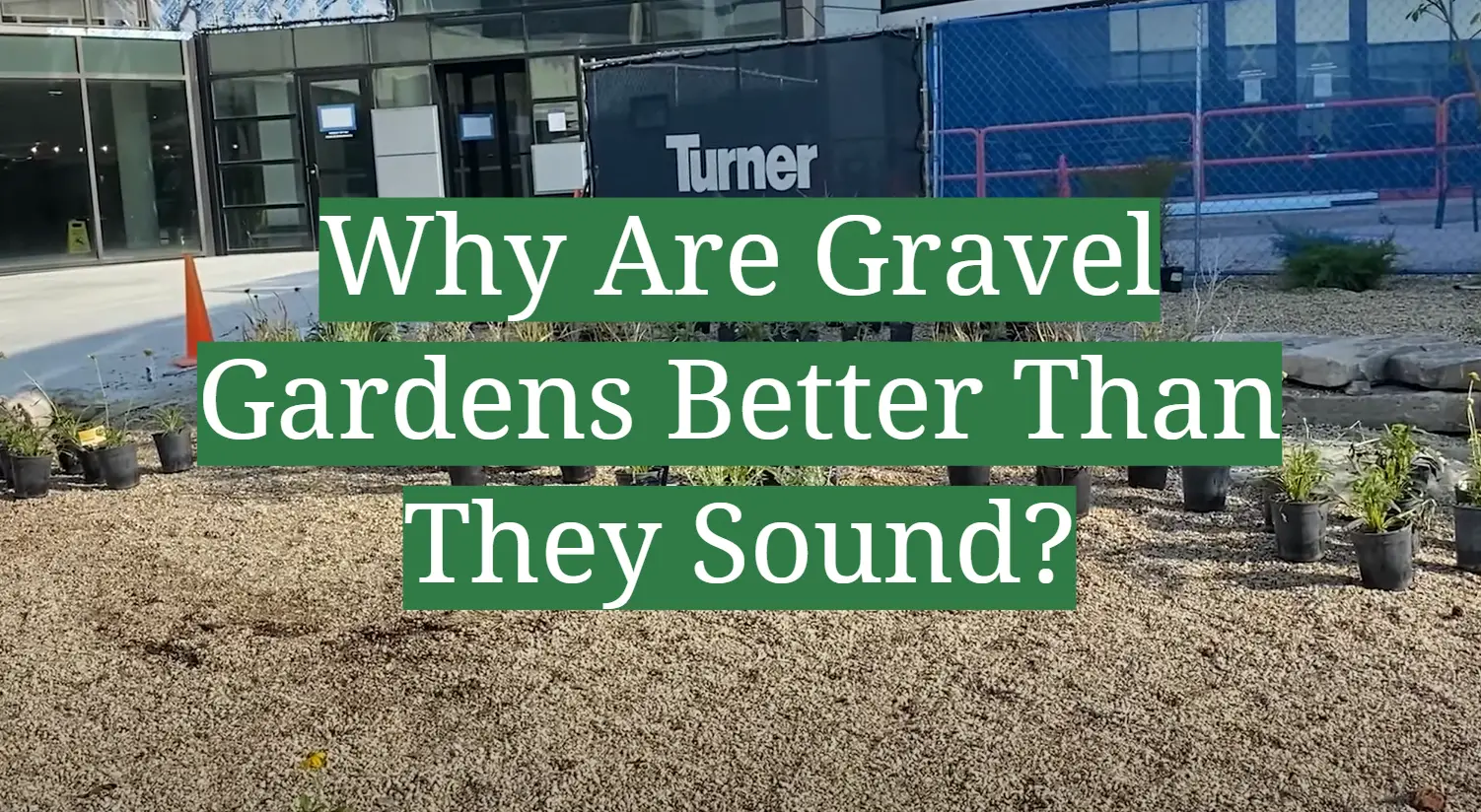




Leave a Reply
View Comments